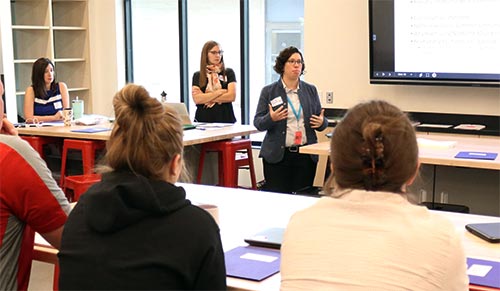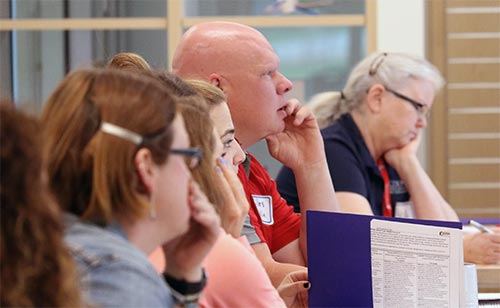Teachers learn to engage students with interactive knowledge-building practices
Dr. Lauren Barth-Cohen is exploring ways to enable students to have an easier time learning science. She aims to translate her research into ways that can be useful to K–12 teachers.

Dr. Lauren Barth-Cohen instructs a group of middle school science teachers in collaboration
with her colleague Dr. Sarah Braden from USU.
To carry out this research, she designs and implements science instruction where students engage in knowledge-building practices. These practices are similar to what professional scientists do, and they are also the norm in current science standards and reform-based science education efforts.
One of these practices involves students generating, testing, evaluating and revising scientific models for phenomena in the world. Examples might be models for how energy from the sun affects Earth’s temperature or models for how magnetism works. Engaging in these active practices enables students to make observations and collect evidence that helps them learn about scientific phenomena in the world.
Using this approach, one of Barth-Cohen’s projects focuses on how 9th graders learn about the physics of energy while enacting an instructional activity known as Energy Theater. In this activity, students use their bodies to act out the flow of energy from the sun to the earth. In the classroom, different regions of the floor represent the Earth and sun. Student walk between these regions to represent the flow of energy while using hand signals to represent different kinds of energy (ultraviolet, infrared, visible, etc).
The collaborative nature of this Energy Theater activity requires students to discuss the scientific content they are modeling and how they are representing that content with their bodies and movements. In her research, Barth-Cohen has shown that, despite common learning difficulties, students are able to discuss and understand the relevant physics. (Barth-Cohen & Wittmann, 2017).

Barth-Cohen’s research has also used Energy Theater to help students learn about climate change. Understanding the physics behind the relationship between energy and temperature can be challenging.
She and her colleagues developed a climate change unit that incorporates Energy Theater. This unit uses a professional scientific model known as “Earth’s Energy Budget” to account for the balance in how energy from the sun impacts the earth and how energy from the earth radiates back to outer space. The instructional unit they developed incorporates this model with Energy Theater to help high school students learn about how greenhouse gases and aerosols in the atmosphere affect temperature (Barth-Cohen, Greenberg, & Moretz, 2018).
This work was published in the National Science Teachers Association (NSTA) flagship journal — The Science Teacher— for high school science teachers. By publishing in that venue, Dr. Barth-Cohen hopes that other high school science teachers will use this method to help students learn about this important topic.
 Recently, Dr. Barth-Cohen began a new project with Dr. Sarah Braden, a faculty colleague
from Utah State University. Together they designed a middle school instructional unit
focused on magnetism.
Recently, Dr. Barth-Cohen began a new project with Dr. Sarah Braden, a faculty colleague
from Utah State University. Together they designed a middle school instructional unit
focused on magnetism.
According to Barth-Cohen, "students observe a series of surprising magnetic phenomena and build a series of increasingly complex scientific models of magnetism." This unit was specifically designed to be accessible for English Language Learners and supports them in learning about important scientific content.
They are currently collaborating with teachers in Utah to implement this unit. They hope to publish their research findings and distribute the instruction to science teachers in the next year.
Barth-Cohen says her interest in science education originated through her own experiences with learning and teaching physics. As an undergraduate, she was a physics major, and her subsequent work in teaching led her to wonder about how people learn and why physics can be so hard to learn? She wondered what can be done to help students learn these challenging conceptual ideas? This personal interest led her down her current path of working with students and teachers at the University of Utah.
Cited articles:
Barth-Cohen, L. A., *Greenberg, K. I., & Moretz, E. (September 2018). A Model for Earth’s Energy Budget: Unpacking the relationship between energy and temperature to understand climate change. The Science Teacher, 86(2), 20–27.
Available behind a paywall at: https://www.nsta.org/publications/browse_journals.aspx?action=issue&id=115132

